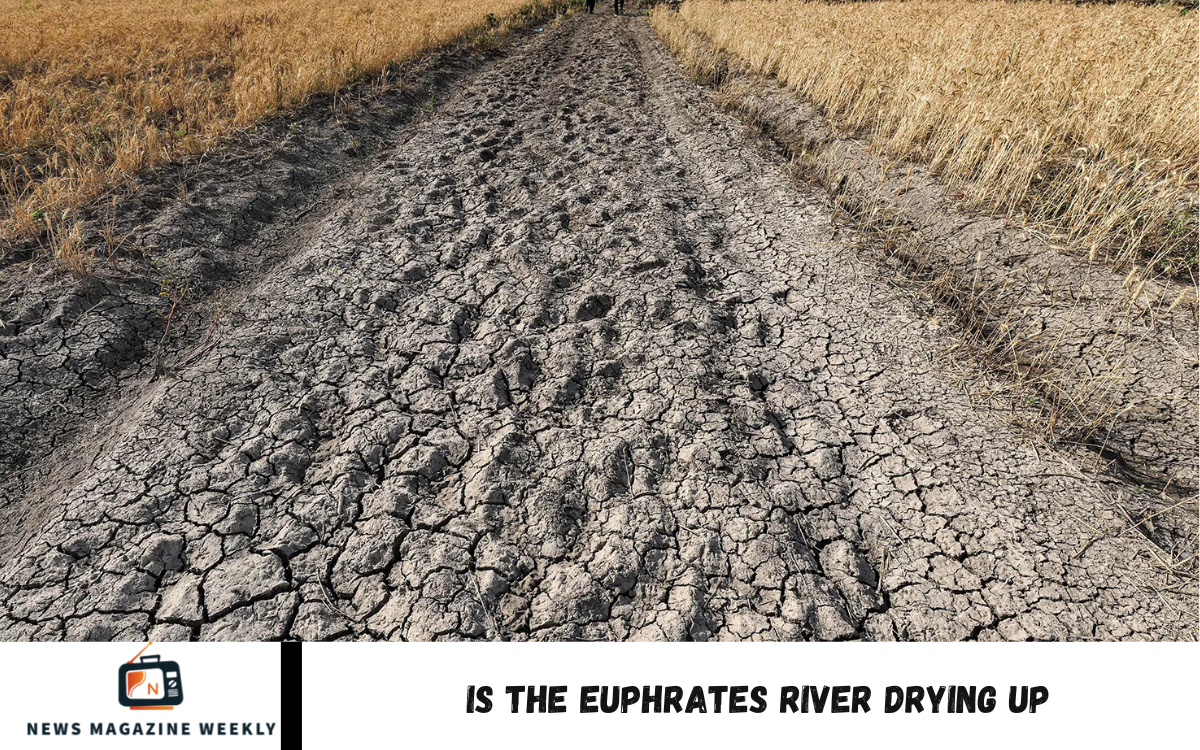The Euphrates River, one of the most significant waterways in the Middle East, has been a lifeline for civilizations for thousands of years. Flowing through Turkey, Syria, and Iraq, it supports agriculture, drinking water, and hydroelectric power for millions of people. However, in recent years, concerns have grown about the river’s declining water levels.
The drying up of the Euphrates poses severe consequences for the region. Farmers struggle with reduced irrigation, leading to crop failures and food shortages. Many communities face water scarcity, forcing displacement and increasing tensions between nations. Additionally, historical and religious significance adds another layer of concern, as some interpretations of ancient texts link the river’s drying to apocalyptic prophecies.
While efforts are being made to address the crisis, including international cooperation and improved water management, the situation remains critical. Without urgent action, the Euphrates River could continue to decline, threatening the livelihoods and stability of millions. Understanding the causes and solutions is crucial to preserving this historic river for future generations.
About the Euphrates River
The Euphrates River is one of the most important and historically significant rivers in the world. It originates in eastern Turkey, flowing through Syria and Iraq before joining the Tigris River and emptying into the Persian Gulf. Spanning approximately 2,800 kilometers (1,740 miles), it is the longest river in Western Asia and has been a crucial water source for civilizations for thousands of years.
The river has played a vital role in agriculture, trade, and the development of some of the world’s earliest civilizations, including Mesopotamia. The fertile lands around the Euphrates have supported human settlements for millennia, giving rise to ancient cities such as Babylon and Ur. In modern times, it continues to be a key resource for drinking water, irrigation, and hydroelectric power.
The Euphrates River has been experiencing a significant decline in water levels due to climate change, dam construction, and overuse. This has raised concerns about water scarcity, food security, and geopolitical tensions in the region. The future of the Euphrates remains uncertain, making it a critical issue for governments, environmentalists, and local communities.
Where is the Euphrates River Located?
The Euphrates River is located in Western Asia and flows through three major countries: Turkey, Syria, and Iraq. It originates in the Taurus Mountains of eastern Turkey, where two small rivers, the Murat and Karasu, merge to form the Euphrates. From there, it travels southeast into Syria, passing through cities like Raqqa and Deir ez-Zor before entering Iraq, where it eventually meets the Tigris River near the city of Al-Qurnah.
Together, these two rivers form the Shatt al-Arab waterway, which empties into the Persian Gulf. The Euphrates is approximately 2,800 kilometers (1,740 miles) long, making it the longest river in Southwest Asia. It has been a crucial water source for civilizations for thousands of years, particularly in the ancient region of Mesopotamia, often referred to as the “Cradle of Civilization.”
Today, the river continues to be a key resource for agriculture, drinking water, and hydroelectric power in the region. However, increasing water shortages and climate challenges threaten its future.
Why is the Euphrates River Drying Up?
The Euphrates River has been experiencing a significant decline in water levels in recent years, raising concerns about its future. Several key factors are contributing to its drying up:
Climate Change and Reduced Rainfall
Global warming has led to rising temperatures and decreased rainfall in the Middle East. Higher evaporation rates and prolonged droughts have significantly reduced the river’s water flow, worsening water shortages in the region.
Dam Construction and Water Management
Several large dams have been built along the Euphrates, particularly in Turkey, Syria, and Iraq, to generate hydroelectric power and store water for irrigation. Notable projects like Turkey’s Atatürk Dam and Syria’s Tabqa Dam have restricted the river’s natural flow, leading to reduced water levels downstream.
Overuse and Unsustainable Water Consumption
The river is a crucial source of water for millions of people, supporting agriculture, industries, and cities. Excessive water extraction for irrigation and domestic use has significantly strained its resources, contributing to its decline.
Geopolitical Conflicts and Water Disputes
Tensions between Turkey, Syria, and Iraq over water rights have further complicated the situation. Disagreements on how much water each country should receive have led to shortages in downstream areas, particularly in Iraq, which relies heavily on the Euphrates for agriculture and drinking water.
Desertification and Soil Degradation
As water levels decrease, once-fertile lands along the Euphrates are turning into deserts. This has forced many farmers to abandon their lands, leading to displacement and worsening food insecurity in the region.
The Urgent Need for Solutions
If the current trends continue, the Euphrates River could face further depletion, threatening millions of people who depend on it. Efforts such as international cooperation, improved water management policies, and climate adaptation strategies are crucial to preserving this vital river for future generations.
Impact of the Drying Euphrates River
The drying of the Euphrates River has severe consequences for the environment, economy, and people living in the region. As water levels continue to decline, millions of people across Turkey, Syria, and Iraq are facing serious challenges.
Water Shortages and Human Displacement
The Euphrates is a significant source of drinking water for millions of people. As the river shrinks, access to clean water becomes increasingly complex, forcing many communities to migrate in search of better living conditions. This has led to growing displacement and humanitarian crises, especially in Iraq and Syria.
Agricultural Collapse and Food Insecurity
The river has supported farming for thousands of years, but declining water levels mean that irrigation systems are failing. Farmers struggle to grow crops, leading to food shortages and rising prices. Many people dependent on agriculture are losing their livelihoods, worsening poverty in the region.
Economic Consequences
With less water available, hydroelectric power plants along the Euphrates are generating less electricity. This results in power shortages, affecting businesses, industries, and daily life. Additionally, the agricultural crisis is weakening local economies, increasing unemployment, and driving people into financial hardship.
Environmental Degradation and Desertification
As the river dries up, formerly fertile land is turning into desert. The loss of water affects ecosystems, leading to the extinction of aquatic species and a decline in biodiversity. The increased spread of deserts and dust storms further worsens air quality and living conditions.
Geopolitical Tensions and Conflicts
The Euphrates flows through multiple countries, and its declining water levels have heightened regional tensions. Disputes over water rights between Turkey, Syria, and Iraq have escalated as each nation struggles to secure its share of the river’s diminishing resources. Water scarcity could become a trigger for further political and military conflicts in the future.
Religious and Historical Concerns
The Euphrates is deeply linked to religious and historical narratives. Some interpretations of ancient texts associate its drying with apocalyptic prophecies, sparking anxiety among believers. Additionally, many archaeological sites along the riverbanks are at risk due to environmental changes.
A Call for Action
The impact of the drying Euphrates River is profound, affecting millions of people, economies, and the environment. Urgent international cooperation, improved water management, and climate adaptation strategies are needed to prevent further devastation and ensure a sustainable future for this historic river.
Read Also: Is Gunung Padang the Oldest Pyramid in the World
The Effect of Dams on the Euphrates River
While dams provide benefits such as hydroelectric power generation and water storage, they have also contributed to the river’s drying up, particularly affecting downstream regions.
1. Major Dams on the Euphrates
The most notable ones include the following:
- Atatürk Dam (Turkey)—One of the largest in the world, this dam is a key part of Turkey’s Southeastern Anatolia Project (GAP). It provides hydroelectric power and irrigation but significantly reduces water flow to Syria and Iraq.
- Tabqa Dam (Syria)—Built in the 1970s, this dam forms Lake Assad, Syria’s largest reservoir, but it also contributes to reduced water flow downstream.
2. Reduced Water Flow to Downstream Countries
Dams in Turkey hold back a significant amount of water, limiting the flow into Syria and Iraq. This has caused severe water shortages in these countries, leading to:
- Declining agricultural productivity due to a lack of irrigation water.
- Drinking water scarcity in many cities and villages.
- Increased desertification, making once-fertile lands unsuitable for farming.
3. Hydroelectric Power vs. Water Scarcity
While these dams produce renewable energy, they also trap large amounts of water, making it unavailable for people, agriculture, and ecosystems downstream. This trade-off has led to conflicts between energy production and water security in the region.
4. Political and Geopolitical Conflicts
Water disputes have intensified among Turkey, Syria, and Iraq, with each country competing for its share of the Euphrates. Turkey, controlling the river’s source, has been accused of using water as a political tool by restricting flow to its neighbors. This has led to diplomatic tensions and, in some cases, protests and regional instability.
5. Environmental Consequences
The reduced water flow caused by dam construction has resulted in:
- Lower water levels in lakes and wetlands affect fish populations and biodiversity.
- Increased salinity in some areas, damaging soil quality and reducing crop yields.
- Erosion and sediment buildup alter the natural landscape of the river.
While dams on the Euphrates River provide economic and energy benefits, their impact on water availability is a growing concern. Sustainable water-sharing agreements, improved irrigation techniques, and international cooperation are essential to balance the needs of hydropower production and water security for millions of people who rely on the river.
Frequently Asked Questions
What role does climate change play in the Euphrates River crisis?
Increased evaporation and reduced rainfall caused water levels in the Euphrates to drop more rapidly than before.
Are there any religious or historical connections to the Euphrates drying up?
Some interpretations of religious texts associate the drying of the river with apocalyptic prophecies.
What environmental impacts does the drying of the Euphrates cause?
The decline in water levels leads to desertification, loss of biodiversity, increased salinity in soil, and ecosystem destruction, affecting both wildlife and human populations.
Have there been any efforts to save the Euphrates River?
Some efforts include water-sharing agreements between countries, improved irrigation techniques, and international aid programs. However, political disputes and ongoing conflicts have slowed progress.
What is the future of the Euphrates River?
If current trends continue, the Euphrates could face severe depletion, leading to worsening water shortages, environmental damage, and geopolitical tensions. Urgent action is needed to improve water management and cooperation between nations to prevent further decline.
Conclusion
The Euphrates River is experiencing a severe water crisis driven by climate change, dam construction, poor water management, and excessive use. Once a vital source of life for civilizations, the river is rapidly shrinking, endangering the livelihoods of millions across Turkey, Syria, and Iraq. The consequences include water shortages, declining agriculture, economic struggles, environmental damage, and increasing geopolitical tensions.

